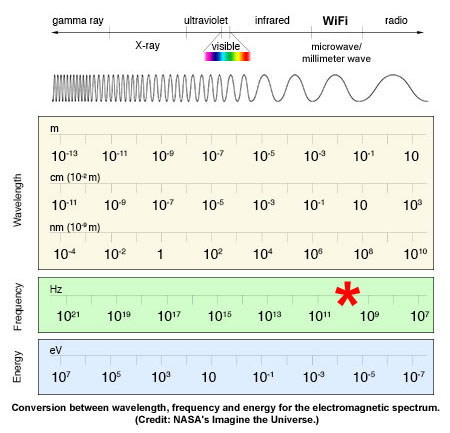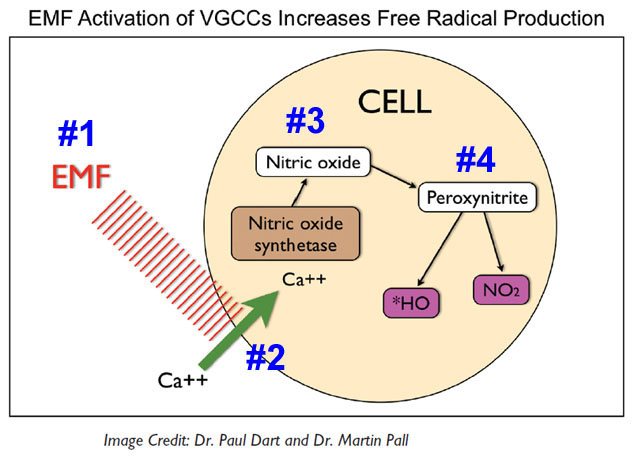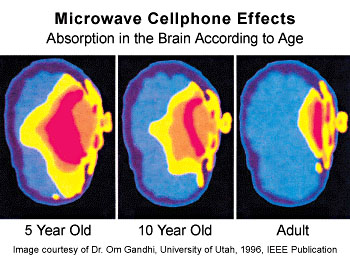 How would you like to be a guinea pig? Guess what – you’ve already been a ‘lab animal’ for your entire life. You’ve been bathed in a flood of radiofrequency radiation since you were in the womb, with little concern about health safety. Defending your health against this onslaught is now a bigger challenge than ever. Here are some things you should know about your role in this experiment and what you can and must do about it to be healthy.
How would you like to be a guinea pig? Guess what – you’ve already been a ‘lab animal’ for your entire life. You’ve been bathed in a flood of radiofrequency radiation since you were in the womb, with little concern about health safety. Defending your health against this onslaught is now a bigger challenge than ever. Here are some things you should know about your role in this experiment and what you can and must do about it to be healthy.
Is Defending Your Health Even Possible?
Well, yes and no.
First off, realize that the multidecades-long expansion of wireless technologies has proceeded without any prior requirement to evaluate their impact on human health. All government approvals for such technologies rest entirely on their economic impact.
The ‘experiment’ that you’re unknowingly participating in is the hindsight gained from discovering how RF radiation can damage human health. This is the same kind of uncontrolled study of human ‘guinea pigs’ that you saw regarding artificial lighting in Part 1 and dirty electricity in Part 2 of this series.
Can you opt out of this experiment? Nope. Defending your health by escaping exposure is not possible anywhere you might live. It’s probably not possible anywhere on the planet.
What you can do about your exposure requires you to take steps toward reducing it as much as you can. Eliminating it completely isn’t up to you. Wireless technologies are ubiquitous. Escaping them is simply not going to happen.
You’re a guinea pig in this ‘health’ experiment regardless of whether you want to be.
Non-Native Electromagnetic Fields (nnEMFs)
The Earth’s surface gets hit with a wide spectrum of electromagnetic radiation from the sun. The table below shows how we measure different properties of the spectrum. Each part of the spectrum is described by its wavelength, its oscillation frequency, and its energy level.
We can only ‘see’ a small part of the EM spectrum – i.e., visible light.
The highest energy levels occur in x-rays and gamma rays. They cause molecules to break up, which is why we refer to them as ‘ionizing’ radiations. Fortunately, ionizing radiations are filtered out by the atmosphere.
The lower energy waves extent beyond the visible spectrum, into infrared light, microwaves, millimeter waves, and radio waves.

The key part of the EM spectrum regarding technology and health is the microwave/millimeter wave region. This is where we have ever-increasing exposure to nnEMFs from wireless communications. (The big red asterisk on the above table highlights this region.)
Wireless technologies have been getting faster due to the use of higher frequencies. The most common frequency – also known as 4G – centers around 2.4 GHz. That’s 2.4 billion cycles per second. The most recent incarnation of wireless speed is 5G. It encompasses a range from 24 to 72 GHz.
SIDENOTE: The high end of 5G is fast approaching the 96 GHz frequency used by the U.S. Army for weaponized crowd control – aka, its “Active Denial System.” Just some food for thought.
Basically, higher frequencies cause you more damage.
Health Effects of High-Speed Wireless Communications
Let’s get right to the core mechanism explaining how wi-fi influences our biology.
One of the main mechanisms describes how RF radiation disrupts key biological antennas residing in our cell membranes. This process is depicted in the following graphic.

My first post on this mechanism (COVID-19 and 5G Wireless – What’s the Link?) focused on how it damages our immune system. However, it’s the basis for all other health consequences, too.
Here’s how it works.
Step 1. A cell is exposed to nnEMFs (microwaves, millimeter waves).
Step 2. These EMFs have perhaps their greatest impact on membrane voltage – i.e., the electrical potential across a membrane. Membrane voltages control the flow of ions (electrical currents) through the membrane. These ion channels act like biological antennas.
Our primary ion channels control the transport of calcium (Ca2+), sodium (Na+), potassium (K+), and chloride (Cl–) across cell membranes.
The most EMF-sensitive of these ion channels is the calcium channel. Step 2 shows the response of these so-called ‘voltage-gated calcium channels’ (VGCCs). Their main response is a loss of control of ion flow. Instead of controlling calcium ions, damaged calcium channels remains continuously open. The immediate result is membrane leakiness – in this case of calcium.
Uncontrolled ion leaks are never a good thing. The worst possible ion for elevated leaks is calcium, based on its phenomenal range of effects. Basically, you never want too much calcium where it shouldn’t be.
Step 3. Excess intracellular calcium induces the enzyme, nitric oxide synthetase, thereby elevating the internal concentration of nitric oxide. All by itself, this may not seem so bad until you get to step 4.
Step 4.This is one of the main ‘pathophysiological’ (damaging) responses of a wide open VGCC. Excess nitric oxide is bled off by the formation of peroxynitrite and its byproducts. Peroxynitrite byproducts are highly inflammatory ROS (reactive oxygen species) and RNS (reactive nitrogen species).
Letting ROS and RNS run rampant is like setting fire to the cell. Without getting too technical, let’s just say all hell breaks loose healthwise.
Initial reports about what that means make up a list of specific ‘cellular fires’, as follows:
- DNA single and double strand breaks and altered gene expression
- Oxidative damage, especially to mitochondrial DNA
- Increased blood brain barrier leakage
- Increased brain glucose metabolism
- Generation of stress proteins
- Changes in cellular free radical activity
- Heating of DNA (even though there is insufficient energy to heat tissue)
- Alteration of heart rhythms
- Altered stem cell development
- Damage to the endocrine system
- Reduction in melatonin levels
- Suppression of the immune system
That’s scary enough all by itself. However, the bigger worries center around what those items mean regarding health outcomes. So far they include the following (and this list is growing):
- Cancer
- Cardiovascular disease
- Memory and learning deficits
- Alzheimer’s Disease
- Chronic fatigue
- Susceptibility to infectious disease
Why Don’t You Notice RF Radiation?
Actually, some people do. These are the ‘canaries in the coal mine’ I referred to in previous posts. They suffer from electrohypersensitivity (EHS). These ‘canaries’ can feel sick by just being too close to a cell phone, a wi-fi router, or a smart meter.
Although you may be lucky enough to not immediately feel RF radiation, it’s still doing a dance on your VGCCs.
A fast-growing number of studies on this topic has produced a bit of a surprise. It’s that the Federal Communications Commission posted a pdf document about it in 2017: Irradiated – A comprehensive compilation of sources of RF Radiation Exposure and Its Effects.
This is surprising because the FCC is the federal agency that normally removes barriers to harmful technologies, with little or no accountability regarding safety. As with all such federal behemoths, the left hand doesn’t seem to know what the right hand is doing.
Nevertheless, the introduction is already a big eye-opener in that report. Take a quick look at it when you get a chance. Take your time. The whole document is more than 400 pages long.
At the moment, I just want to focus on one aspect of health damage from wireless technologies – brain health. (I already addressed immune system health in that post linked above.)
One of the first effects on brain health, discovered more than 20 years ago, is the impact of cell phones on the blood brain barrier. The BBB is a protective barrier for controlling what gets into and out of the brain. Cell phone radiation makes it leak.
Not only that, the impact is much greater in children than in adults. See below.

A child’s neurological development is extremely vulnerable to RF radiation. All those 10-year-olds with their own cell phones are inviting major neurological trouble right into their heads. Unfortunately, parents don’t seem to know better. And peer pressure to have a phone (and to use it extensively) is off the charts at that age.
Now here’s a thought meant to scare you: Even though you don’t feel the disintegration of your blood-brain barrier, it’s happening every time you put a cell phone up to your ear. Your first ‘feeling’ may manifest as headaches or blurred vision. Or nothing may seem to be happening until you develop a brain tumor. If it turns out to be a GBM (glioblasoma multiforme), you have an 80% chance of dying from it within 24 months.
My apologies for going all ‘Stephen King’ on you there. Nevertheless if it substitutes for vigorous shoulder shaking to scare some sense into you, then I’ve done some good.
With all that background, and some links to go for further information, the question becomes: What can you do about all this?
Ah, now we’re getting somewhere.
Reducing Exposure to RF Radiation
The most effective avoidance strategy would be to spend all your time in a Faraday cage. Of course, that’s not going to be practical or cheap.
If we just focus on cell phones, here’s some pretty good advice from an unlikely source (i.e., your federal government again – the FDA this time):
- Reduce the amount of time spent using your cell phone.
- Place more distance between your head and the cell phone. Use speaker mode or air-tube style head phones or ear buds (i.e., not wired or wireless).
- Avoid making calls when the signal is weak as this causes cell phones to boost RF transmission power. This is exactly what happens when you use your cell phone in a vehicle or on an airplane. [The Faraday effect inside a metal vehicle causes RF transmission power to rise.]
- Consider texting rather than talking – but don’t text while you are driving.
In principle, the further away you are from an RF emitter the better. Exposure intensity drops off with the square of the distance from the source. This means, for example, the RF intensity from 3 feet away is 9 times lower than from 1 foot away.
That’s a pretty good start.
Health advice from the FDA is often disingenuous. Federal agencies often aren’t your friends. In fact, that page linked above starts out with this comment:
The scientific evidence indicates radio frequency (RF) exposures that are at or below current U.S. safety limits do not cause health problems. There is no established health benefit from reducing an individual’s RF exposure from cell phones.
The not-so-subtle flaw in that statement is, “…exposures at or below current U.S. safety limits do not cause health problems.” Do you suppose the wireless tech industry might have had a lobbyist or two paying to establish those industry-friendly safety limits?
Well, DUH!
How about other sources of RF radiation?
The next most common exposure for most people comes from a home wi-fi router. The router signal runs all the smart devices in your home. If this includes your laptop, the easiest thing to do is convert to a hardwired “ethernet” cable connection between your computer and your household internet modem. (You then have to disable the wi-fi functionality in both the computer and the modem.)
As for other smart devices, you have to decide what’s really important in your life. Can you live without a smart TV? Wireless stereo speakers? Alexa? A front door security camera linked to your cell phone? An RF-controlled (‘driverless’) vacuum cleaner? How about a FitBit, Apple Watch, or other wireless wearables?
The list seems endless, doesn’t it?
Wait, there’s more!
Indeed, there is so much more you can do. The possibilities are like a smorgasbord of choices. The best ‘menu’ I’ve seen for reducing exposure to RF radiation comes courtesy of an Austrailian group, EMR Aware, here: Electromagnetic Radiation – Concerns and Informed Choices.
Take a peek at that page to see a pretty extensive set of strategies for reducing your exposure to RF radiation in your home (and office, too).
Wireless Technology and Sneaky Pandemics
The COVID-19 outbreak is just the most recent manifestation of how wireless technologies can influence disease development (see: Surprising Truths Behind the Coronavirus Pandemic). As challenging as COVID-19 has been, it’s like a mosquito on an elephant’s back side in comparison with what I call ‘sneaky’ pandemics. These consist of an accelerated worldwide rise in numerous Diseases of Civilization.
If we just stick to the theme of brain health here, these pandemics encompass all manner of dementia (especially Alzheimer’s Disease), Parkinson’s Disease, and the fastest-growing neurological disorder of all – autism.
Other neurological ‘pandemics’ now also include MS and ALS.
This shouldn’t be surprising, since cellular antennas (i.e., VGCCs) are especially prevalent in the high-energy cells of brain and nerve tissues. The same goes for heart tissues.
One more thing, then I’ll quit scaring you. (For now.) Cancer arises from compromised energy metabolism in mitochondria – the energy powerhouses of most cells (not red blood cells).
Science has known about the biochemistry of cancer since the 1930s. Now we know much more about the biophysics behind tumor development. Mitochondrial energy dysfunction is the key. RF radiation simply ruins a cell’s ability to properly harvest and distribute cellular energy. This is a major factor behind the appearance of cancer clusters in, for example, schools.
Most schools are RF radiation hotspots. Your home may be one, too. Likely your office as well.
Are you up for wearing a tinfoil hat in those locations? While that may provide some benefit, you can take many other steps to mitigate the effects of microwaves and millimeter waves. (See that link to EMR Aware again.)
Time to Get Out of Town?
Moving is also an option. This may be the most difficult and inconvenient strategy of all. However, if you live in a big city, near an airport or military base, close to a seaport (big ships are cesspools of wireless communications technologies), or anywhere near a microwave tower or high-voltage power line (above or below ground – you have to check), you’re just another guinea pig in a vast uncontrolled health experiment.
One of the biggest challenges for figuring out any kind of health issue is discovering its cause. Determining cause-and-effect in science is a logistical nightmare. It’s even harder when you have only one data point – i.e., yourself.
Nevertheless, you can do certain kinds of experiments on yourself. Regarding RF radiation, you can do the equivalent of an elimination diet. Choose one or more symptoms to follow. Then eliminate exposure to as much wi-fi as you can.
One of the first improvements that are typical is better sleep. That’s the bedrock for all kinds of health benefits. Start with that and see what happens.
Yes, there’s a lot to know and a lot to do when it comes to defending your health in a high tech world.
However you approach your use of and exposure to RF radiation, keep this uppermost in mind:
a disease state. You will never be able to overcome any disease
in the same environment that led to it.
Now get busy!
Comments or Questions?
I’d love to hear from you. This and every other post here provides a comment section at the end of the post, exactly for that purpose.
So, by all means, leave me your thoughts.
I would be especially grateful if you point out any flaws in my logic, factual errors, or ordinary typos. (I’ll give you a little ‘huzzah’ in my heart.)
Then I’ll respond as soon as I can.
All the best in natural health,
![]()
Statements on this page have not been evaluated by the Food and Drug Administration. Information here is not is not intended to diagnose, treat, cure, or prevent any disease.
I may receive a commission for purchases made through those links.
This doesn’t change the cost to you.
Dr. D,
Great insight for many facets of our lives now & in the future of our personal health & well-being. It is all around us & most do not take the time to do all this research & to openly give us facts & positive input, in order for us to make intelligent decisions, as to what we need to do to be aware and to be educated about the real cause & effect issues, that face us all.
Thanks for being on top of these situations & answers to many concerns at this time in all of our lives.
Thanks for your kind comments, Ron. I’m happy to know that my research helps folks who can think critically, just as you do.
Cheers,
Dennis